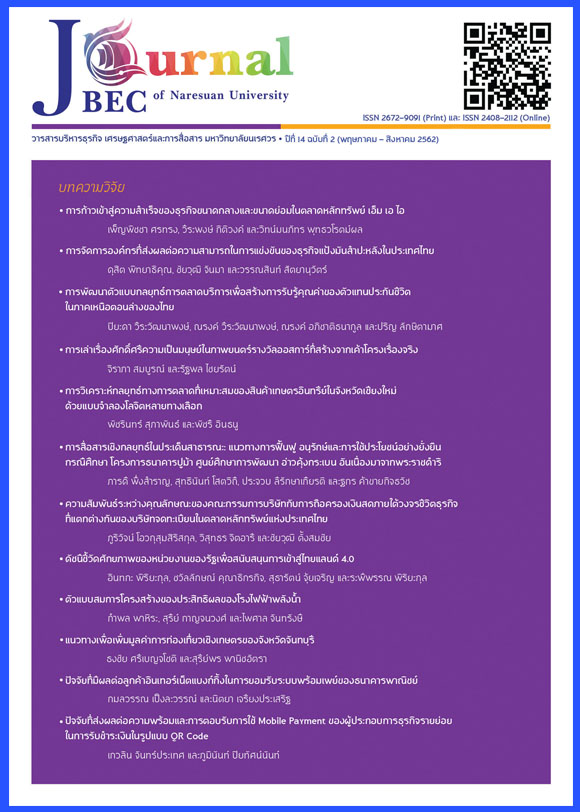การก้าวเข้าสู่ความสำเร็จของธุรกิจขนาดกลางและขนาดย่อมในตลาดหลักทรัพย์ เอ็ม เอ ไอ
Main Article Content
บทคัดย่อ
บทความนี้มีวัตถุประสงค์เพื่อวิเคราะห์วงจรธุรกิจ ค้นหาปัจจัยที่นำไปสู่ความสำเร็จ และศึกษาแนวทางการปรับตัวเข้าสู่ยุคไทยแลนด์ 4.0 ของธุรกิจในตลาดหลักทรัพย์ MAI เพื่อนำไปสู่การสร้างแนวทางปฏิบัติที่ดี สำหรับธุรกิจขนาดกลางและขนาดย่อม การศึกษานี้เป็นการวิจัยเชิงปริมาณและเชิงคุณภาพ ซึ่งประกอบด้วยการวิเคราะห์ข้อมูลทางการเงินของบริษัทจดทะเบียนจำนวน 137 บริษัท การวิเคราะห์ใจความสำคัญข้อมูลจากการสัมภาษณ์ผู้บริหาร และการวิเคราะห์องค์ประกอบ การวิเคราะห์สหสัมพันธ์ และการวิเคราะห์การถดถอยพหุจากข้อมูลจากแบบสอบถาม จากการวิเคราะห์พบว่า บริษัทในตลาดหลักทรัพย์ MAI ส่วนใหญ่อยู่ในขั้นการดำรงอยู่ ที่กำลังก้าวเข้าสู่ขั้นความสำเร็จ ซึ่งบริษัทส่วนใหญ่เริ่มเป็นที่รู้จักในตลาด มีการสร้างเสถียรภาพในด้านการตลาด ลักษณะส่วนบุคคลของผู้บริหาร ภาวะผู้นำ และกลยุทธ์และสภาพแวดล้อมภายนอก เป็นปัจจัยที่นำไปสู่ความสำเร็จโดยบริษัทส่วนใหญ่ใช้กำไรสุทธิ อัตราการเติบโตของยอดขาย อัตราเติบโตของรายได้รวม และกำไรขั้นต้น เป็นตัวชี้วัดความสำเร็จ สำหรับแนวทางปฏิบัติที่ดีนั้น ผู้ประกอบการควรมีการสั่งสมประสบการณ์องค์ความรู้ด้านบริหารธุรกิจ และมีกระบวนการแก้ไขปัญหาอย่างมีประสิทธิภาพ โดยผู้ประกอบการควรเลือกใช้กลยุทธ์ให้เหมาะสมกับสภาพของธุรกิจ และนำเทคโนโลยีสมัยใหม่เข้ามาใช้กับผลิตภัณฑ์ การบริการ และกระบวนการบริหารจัดการ เพื่อพัฒนาศักยภาพธุรกิจของตน และสร้างความได้เปรียบทางการแข่งขันกับคู่แข่งทางการค้าในท้ายที่สุด
Article Details
References
2. Boonyakit, B. and Siripanit, K. (2003). Benchmarking. Bangkok: Thailand Productivity Institute.
3. Chang, W. S. and Hsieh, J. (2011). The dynamics of intellectual capital in organizational development. African Journal of Business Management, 5(6), 2345-2355.
4. Chittithaworn, C., Islam, M. A., Keawchana, T. and Yusuf, D. H. M. (2011). Factors affecting business success of Small and Medium Enterprises (SMEs) in Thailand. Asian Social Science, 7(5), 180-190.
5. Churchill, N. C. and Lewis, V. (1983). The five stages of small business growth. Harvard Business Review, 61(3), 30-50.
6. Cormican, K. and Sullivan, D. (2004). Auditing best practice for effective product innovation management. Technovation, 24(10), 819-829.
7. Department of Industrial Promotion, Ministry of Industry. (2015). Annual report 2015. Retrieved February 5, 2017, from https://www.dip.go.th/files/article/attachments/dip/9c7bd208cb4cc7364ec6eb735655ce9a.pdf
8. Ghosh, B. C., Liang, T. W., Meng, T. T. and Chan, B. (2001). The key success factors, distinctive capabilities and strategic thrusts of top SMEs in Singapore. Journal of Business Research, 51(3), 209-221.
9. Grunert, K. G. and Ellegaard, C. (1992). The concept of key success factors: Theory and method (MAPP Working Paper no 4). Centre for market surveillance, research and strategy for the food sector. Retrieved January 24, 2017, from https://pure.au.dk/portal/files/32299581/wp04.pdf
10. Hair, J. F., Black, W. C., Babin, B. J. and Anderson, R. E. (2010). Multivariate data analysis (7th ed.). Upper Saddle River, N.J.: Prentice Hall.
11. Hassan, T. M., Yaacob, M. R. and Abdullatiff, N. K. (2014). Sustaining SMEs wood-based product manufacturing through best practices–The case of indigenous entrepreneurs in Kelantan. Procedia-Social and Behavioral Sciences, 115(February 2014), 221-234.
12. Indarti, N. and Langenberg, M. (2004). Factors affecting business success among SMEs: Empirical evidences from Indonesia. Second Bi-Annual European Summer University, 3(2), 19-21.
13. Institute for Small and Medium Enterprise Development. (2005). Main problems for SMEs. Retrieved February 5, 2017, from https://www.ismed.or.th/define.php
14. Jasra, J. M., Hunjra, A. I., Rehman, A. U., Azam, R. I. and Khan, M. A. (2011). Determinants of business success of Small and Medium Enterprises. International Journal of Business and Social Science, 2(20), 274-280.
15. Katz, J. A. and Green, R. P. (2009). Entrepreneurial small business (2nd ed.). Boston: McGraw-Hill Irwin.
16. Kazanjian, R. K. (1988). Relation of dominant problems to stages of growth in technology-based new ventures. Academy of Management Journal, 31(2), 257-279.
17. Kemayel, L. (2015). Success factors of lebanese SMEs: An empirical study. Procedia-Social and Behavioral Sciences, 195(July 2015), 1123-1128.
18. Kim, Y. (2015). Consumer user innovation in Korea: An international comparison and policy implications. Asian Journal of Technology Innovation, 23(1), 69-86.
19. Kumar, R., Singh, R. K. and Shankar, R. (2015). Critical success factors for implementation of supply chain management in Indian Small and Medium Enterprises and their impact on performance. IIMB Management Review, 27(2), 92-104.
20. Lampadarios, E. (2016). Critical success factors for SMEs: An empirical study in the UK chemical distribution industry. International Journal of Business and Management, 11(7), 67-82.
21. Limam, M. S. and Reijers, H. A. (2007). Best practices in business process redesign: Use and impact. Business Process Management Journal, 13(2), 193-213.
22. Mahrouq, M. (2010). Success factors of Small and Medium Enterprises: The case of Jordan. Zagreb International Review of Economics and Business, 13(2), 89-106.
23. Murray, J. A., Driscoll, A. and Torres, A. (2002). Discovering diversity in marketing practice. European Journal of Marketing, 36(3), 373-390.
24. NIDA Poll. (2017). SMEs and obstacles in business operations the economy of 2015. Retrieved January 24, 2017, from https://nidapoll.nida.ac.th/index.php?op=polls-detail&id=49
25. Nicholas, J., Ledwith, A. and Perks, H. (2011). New product development best practice in SME and large organisations: Theory vs Practice. European Journal of Innovation Management, 14(2), 227-251.
26. Office of Small and Medium Enterprise Promotion. (2012). Master plan Small and Medium Enterprise promotion 3 (2012-2016). Bangkok: Office of Small and Medium Enterprise Promotion.
27. Office of Small and Medium Enterprise Promotion. (2016). SME white paper 2016. Bangkok: Office of Small and Medium Enterprise Promotion.
28. Philip, M. (2010). Factors affecting business success of Small and Medium Enterprises (SMEs). Amity Global Business Review, 6(1), 118-136.
29. Rahman, M. N. A. and Tannock, J. D. (2005). TQM best practices: Experiences of Malaysian SMEs. Total Quality Management and Business Excellence, 16(4), 491-503.
30. Sirimahasakorn, B. (2005). Knowlage management best practice. Journal of Teachers Professional Development, 104(7), 58-63
31. Siriwan, U., Ramabut, C., Thitikalaya, N. and Pongwiritthon, R. (lecturer). (2013). The management of the Small and Medium Enterprises to achievement competitive advantage in Northern Thailand. In Conference of the International Journal of Arts and Sciences (pp. 147-157). USA: University Publications.net.
32. Sheikh, S. (2018). CEO power, product market competition and firm value. Research in International Business and Finance, 46(December 2018), 373-386.
33. Thailand Productivity Institute. (2003). Case study process management best practices. Bangkok: Thailand Productivity Institute.
34. Thailand Quality Award. (2015). TQA criteria for performance excellence framework. Bangkok: Eastern Printing Public Company Limited.
35. Thailand Securities Institute. (2014). Finance market and investment in securities for securities invesment consultant. Bangkok: Amarin Printing and Public Company Limited.
36. The Securities Exchange of Thailand. (2002). Securities analysis using basic factors. Retrieved March 28, 2018, from https://www.set.or.th/education/th/begin/stock_content04.pdf
37. Valmohammadi, C. (2010). Identification and prioritization of critical success factors of knowledge management in Iranian SMEs: An experts' view. African Journal of Business Management, 4(6), 915-924.

